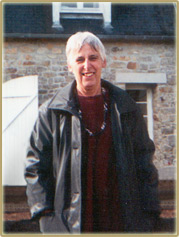
Country Life
In 1996 I moved my pen and my piano into a Britanny paradise called Yanavalon, watched over by a Bouvier Bernois dog and forty apple trees. The cat spends her life sleeping or purring in the armchair or outside hunting field mice. My sons call me a bucolic folk writer and I take that as a compliment.
Biography
I was born in Quimper, beside the River Odet, just before the Second World War. My father was away fighting in the war and so my mother, my sister and I went to live on the other side of the town with my paternal grandparents from whence I derive my childhood memories of throbbing aero engines, my grandmother's piano and the stories that my aged aunt read constantly to me. It is certainly from this time that stem my fear of military aircraft, my love of music and my passion for literature.
I wrote my first book when I was eleven years old. It was about my beloved dog, a mongrel with extraordinary instincts, who had spent the war in Indo China as a mascot with the Foreign Legion. After that, nothing in particular for forty years although I led a full life. I lived in many places, Tunisia, Algeria, England, Germany; I was married, I had my children and after I was divorced I climbed the secretarial ladder.
In my fifties I was made redundant. That provided the opportunity to write my first detective novel Dis-moi qui tu aimes, je te dirai qui tu hais, inspired by my extensive experience of the international, albeit restricted world of high level mathematicians and physicists. This book has since been republished under the title Maths à mort.
I then started writing historical novels, mainly because they allowed me to travel in time and space as quickly and cheaply as possible, that is through writing. And so I produced Au diable les yeux verts which is set in Quimper before the First World War; L'Enfant d'outre-tombe, a historical novel set in the area around Chateaubriand, which won me le Prix Bretagne in 1995, thus allowing me to spend a delightful fortnight of intensive study for several years at the Maison de Chateaubriand at Chatenay-Malabry. Afterwards came La Nuit est aussi lumière, half novel, half philosophy, then Laennec, l’homme à l’oreille d’or, published in partnership with la Fondation pour la Recherche Médicale.
In 2007, I published a book written with the young people of the Charcot Psychiatric Hospital (near Lorient). The book Je marche mieux quand ma main serre la tienne tells of their world of suffering as well as their hopes.
Then I wrote new children' novels: Marion du Faouët ou la révolte des gueux (Oskar Jeunesse, 2008), L'Épée de Charlemagne (Oskar Jeunesse, 2009), L'Oreille d'or du Dr Laennec, une révolution dans la médecine (Oskar Jeunesse, 2010), Cartouche, roi de Paris (Oslo Poche, 2011), and Mandrin, gentilhomme de la contrebande (Oslo, 2013).
In 2015, I published L'Énigme de la Vallée-aux-Loups (Oskar Jeunesse), historical novel for young people that takes place during the Napoleonic Empire, at Vicomte de Chateaubriand's.
I am a member of La Société des Gens de Lettres (Literary Society) and of L'association des Écrivains Bretons (Breton Writters Association).
(My earlier childrens' novels Les Aventures de Marion du Faouët, Les sept épées du Moine, Le Poison de Morgane and L’enfant Mystérieux published by Liv’Editions have been out of print for several years).